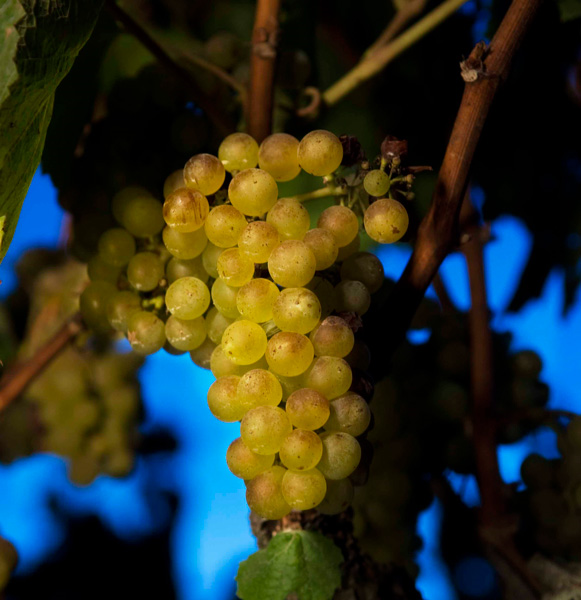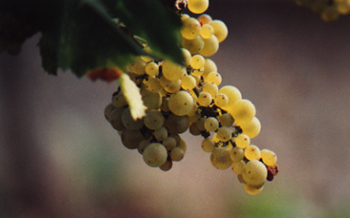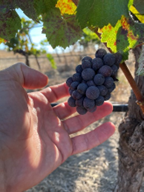Here are some descriptions of the clones we have (or have had). This might be of interest if you are planning a vineyard. Otherwise, think of clones as different expressions of grape varietals. It’s worth knowing that a good site and a bad clone beats a good clone and a bad site. That said, we like to think we have a good site and good clones.
Chardonnay
F.P.M.S. # 4 A field selection taken in 1990 from the Vandendriesche's White Rock Vineyards, Napa Valley, probably mainly UCD # 4, which is a heat treated version of Old Wente. (For additional remarks on the history of UCD # 4 and Old Wente, see below.) Perhaps because it is a field selection we saw a lot of heterogeneity among clusters, ranging from the chicks and hens of classic Old Wente, to larger, big berried clusters. On average our heaviest Chardonnay cluster, at around 0.31lb per cluster. Seems to get better each year, showing delicious tropical and citrus flavors at harvest. Also contributes to the weight of the wine. Dr. Olmo, of UC Davis, took this selection from the Stanly Ranch in 1955 (at that time owned by Louis Martini).

Old Wente – field Selection A consistent star in our Chardonnay program. Our selection was taken via Larry Hyde's Carneros vineyard. Clusters are usually quite small and show a classic "chicks and hens" morphology, large and small berries in the same cluster. In addition to exhibiting an array of apple, citrus and spice flavors, Old Wente seems especially good at capturing the unique mineral character of Adastra's soil. For the last two years, Old Wente has been the last of our Chardonnay to ripen.

Dijon 96 Medium-sized, tightly packed clusters. Consistently brings a pear character to the wine, usually with tropical notes also. Some data suggests this clone is twenty percent heavier bearing than clone 76. We have not found this to be true at Adastra, where neither clone has been consistently more productive than the other. All the "Dijon" clones at Adastra are descended from clones imported from the Dijon Experimental Station by Oregon State University in 1987. Ultimately traced to Meursault, France.
Dijon 95 A newcomer to our vineyard in 2001, 95 came with a reputation for bringing richness to the palate of wines. So far the indications are promising. In 2002 the grapes had a strong honey element at harvest. The budwood came from Saintsbury's Brown Ranch via Caldwell Nurseries. Ultimately traced to Meursault, France.
Dijon 76 Planted next to the 96 in our vineyard. Similar cluster morphology to 76, also usually has tropical flavors and a grapefruit component. Ultimately traced to the Saone et Loire region of France.
Pinot Noir
Dijon 115 Very consistent for a Pinot Noir clone. Small, jammy berries good color and texture. "Sassafras" has been a consistent descriptor since the inaugural 2002 Adastra fermentation.
Dijon 113 Somewhat similar to Dijon 115, but a little less consistent. In some years it has been the favorite, in others it has been not.
Dijon 777 Budded to in 2003, this Burgundy clone has a reputation for producing high quality wines with good color; tends towards small, tight clusters.

Pommard F.P.M.S. # 4 Produces quite large clusters for Pinot Noir, but the juice is usually good and jammy with a good textural quality.
Wadenswil F.P.M.S. # 2A This clone comes from Wadenswil, Switzerland where there is a viticultural research station. In California it is often thought of as a "spice" clone, adding exotic spice character and consistently good color. Pinot Noir in Switzerland probably came from Burgundy (its local names there include Blau Burgunder) although selections have doubtless undergone mutations over time.
DRC – field selection Originated in the Domaine de la Romanée-Conti vineyard of Burgundy. Budwood from that vineyard found its way to vineyards in California, and ultimately to Adastra. The clusters are relatively large, but seem to add an intensity of flavor to our Pinot Noirs. It brings its own mystique.
Swan – field selection Like the Old Wente, Swan is an heirloom selection, originating from the expeditions of another California pioneer, in this case Joseph Swan. Usually has a combination of larger and smaller berries. Tends to be among the favorites but has a reputation for being tricky to vinify; consistently spicy; very good rosé component. If you had two vines side-by-side, each with 20 clusters, our experience suggests the Swan would make a lighter, more delicate wine. Ultimately, leafroll virus became so prevalent that we removed all the Swan. Our budwood came from Carneros Creek and Robert Mondavi.
Merlot
F.P.M.S. # 3 Another Vandendriesche field selection; given the age, this is almost certainly UCD # 3. Left to its own devices, this clone can produce large clusters with "wings" (sub-clusters forming off the main cluster). However, by trimming wings and thinning to one cluster per shoot, we have been pleased with this selection. The berries tend to produce complex flavors with deep red roses, plum, spice and chocolate being consistent from year to year. UC Davis took this selection from Inglenook vineyard (now owned by Niebaum-Coppola). The selection was probably brought over from France to the U.S. by Gustav Niebaum.
F.P.M.S. # 6 This is the main clone in our newer plantings. Again we thin to one cluster per shoot and remove wings. This clone provides raspberry/ strawberry, black cherry and plum components with has consistently good color. UC Davis took this selection from Martini's Monte Rosso vineyard (now owned by Gallo). This is currently the only Merlot clone we have.
F.P.M.S. # 1 A less refined version of FPMS # 6 which tends to produce more wings. Flavors often include a raspberry tea character as well as plums and cherries. Another selection taken by UC Davis from Inglenook (see above). Because this clone did not always make the blend, we abandoned it in 2003.
F.P.M.S. # 8 This clone proved a royal pain to manage. It often produced shot berries (berries which do not ripen). In some years it added a pleasing width and minerality to the palate of the main wine, but in other years its green, herbaceousness has led us to exclude it from the final blend. This clone is credited by UC Davis as coming from Argentina (and therefore, probably originally from Bordeaux). Like F.P.M.S. # 1, this clone was abandoned in 2003.
Syrah
470 Most famously associated with the Rhone Valley and Australia, Syrah (aka Shiraz) has a reputation for generous yields and distinctive flavors. We were interested in replacing Merlot clones 1 and 8, but didn't like the Merlot alternatives, so we decided to try Syrah 470 in 2003 with the idea of making wine from it that we would then blend with the Merlot prior to bottling. Clone 470 is reputed to produce high quality wine at lower yields than most other Syrahs. Although it is too early to pass judgment, we can say that it has large, loose clusters, which we trim and that it ripens later than all the other grapes in the vineyards. The Syrah made its first appearance as a small component of the 2004 Adastra Merlot. Starting in 2005 we made varietal bottlings of Syrah, which have been very well received.
Simple Definitions
Budwood Canes (with buds) cut from a vine. The buds on the cane are grafted onto rootstocks to form new plants.
Clone In the plant world, a clone is "a population of plants all members of which are the descendants by vegetative propagation of a single individual” (1. C.P. Meredith). Thus, for a given Dijon 115 Pinot noir vine to be a true clone, one would have to be able to trace its origin back to a single mother vine in Burgundy. True grapevine clones are usually certified by a research institution e.g. Foundation Plant Services at UC Davis, ENTAV in France. These institutions maintain small numbers of many different grapevine clones and sell cuttings, usually to nurseries, which propagate them and make them more widely available, with certification. Grape material that has been certified is free of known diseases and viruses. The term “clone” is often used loosely to refer to both true clones and field selections.
Field Selection (also known a "mass selection") Budwood is collected from throughout the vineyard, rather than from a single vine. This happens much of the time. Our Old Wente budwood came from several vines in Larry Hyde's vineyard and is thus a field selection.
About F.P.M.S.
In 1951 Dr. Harold Olmo visited Europe financed by the California Wine Advisory Board and tasked with collecting outstanding clones of wine grape varieties to bring back to California. A foundation vineyard was provided at UC Davis. In 1953, the California Grape Certification Association began collecting more clones and began a program of indexing. In 1958, fruit trees and ornamental plants were added to the program at Davis and the name changed to Foundation Plant Materials Service (F.P.M.S.). 2 The first grape material of certified origin in the United States was sold in 1959. Today this process is ongoing. A vine that is F.P.M.S. certified can be traced back to a mother vine on the Foundation block. Certified vines are tested for known diseases and viruses prior to certification. The F.P.M.S. sells the budwood from the vines, usually to nurseries, the nurseries cultivate more vines and sell them to growers. A proportion of the cost of each vine purchased from a nursery is a levy which goes to the F.P.M.S. to perpetuate its work. F.P.M.S. certification can take several years. As a result, some impatient growers have informally imported budwood for themselves in their suitcases, giving rise to the term "Samsonite clone." (Here the term "clone" and, presumably, the brand of suitcase, is loosely defined.) Other institutions in other States also officially import budwood.
Old Wente: A Brief Convoluted History
In 1882, Charles Wetmore, President of the California State Viticultural Commission and owner of Cresta Blanca winery brought back some budwood cuttings from Meursault, Burgundy (France). 3 He dispersed this budwood among the vineyards of the Livermore Valley, California. In 1912, a member of the Wente family traveled to Europe and took cuttings from the University of Montpellier viticultural nursery in France. These cuttings took pride of place in the Wente vineyard in Livermore, along with cuttings taken from the Gier vineyard which had used some of Wetmore's budwood. Budwood taken from the Wente vineyard by other growers became known as "Wente."
In 1948, Fred and Eleanor McCrea collected budwood from Wente's vineyard for their Stony Hill Vineyard in Napa. Louis Martini took budwood from Stony Hill and referred to it as "Wente." Budwood from some of Martini's vines was selected by Howard Olmo in 1955 and taken to the Foundation block at UC Davis. Olmo selected material from vines which had a good yield and were apparently disease free. At the Foundation block the vines were grafted, tested, and eventually certified. Recordkeeping at the University was apparently sketchy, but is believed that some of the Wente material collected by Olmo was certified as F.P.M.S. clone 4. This clone is therefore sometimes called "Wente" or "heat treated Wente." Non-certified budwood, like that taken by the McCreas is often referred to as "Old Wente." To complete the picture, among those who took "Old Wente" from the McCreas was Long Vineyard. Among those who took budwood from the Long Vineyard (again in a mass selection, rather than from a single vine) was Larry Hyde. We took our budwood from Larry Hyde's vineyard in 1995, again in a mass selection, choosing wood from an area of the vineyard which had produced particularly aromatic and intensely flavored grapes. Since then, this section of Mr. Hyde's vineyard has been replanted due to phylloxera.
1 "The Nature of Clonal Variation in Winegrapes: Review" by M.G. Mullins and C.P. Meredith in Proceedings of the Seventh Australian Wine Industry Technical Conference, Adelaide, Australia, 14-16 August, 1989 (T.H. Lee, ed.)
2 "The California Grape Certification Program" H.P. Olmo at First Semana Internationale del Vino, Jerez, Spain, 1975
3 Much of the information in "Old Wente" comes from "Chardonnay: Buds, Twigs and Clones" by Gerald Asher, Gourmet May, 1990
